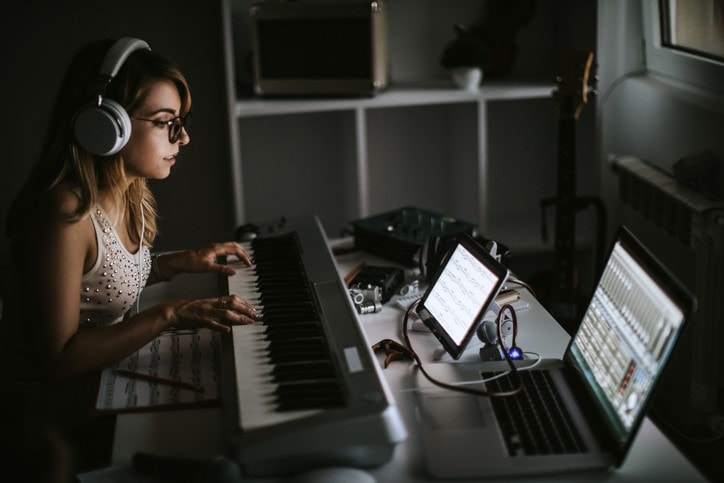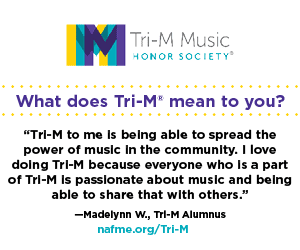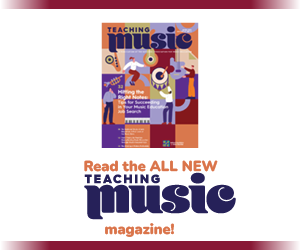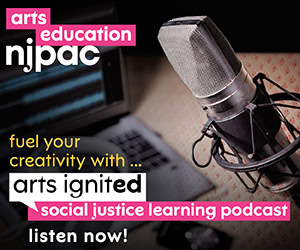/ News Posts / Production through Performance
Getting out of the Loop
Production through Performance
By NAfME Member Bob Habersat
Music technology is the perfect gateway class for new students to get involved in your music program. Music production is becoming incredibly appealing because of social media platforms like SoundCloud and YouTube where content creators are getting more claim and media attention than some artists with record deals. Offering a course that shares the excitement that students get from following their favorite music producers is very powerful and can be transformative to your program.
However, there is a problem that can occur when teaching this class. I’ve been teaching music technology for the past nine years, and I have had a love/hate relationship with the course until recently. The first projects that I used to do with my students were based around dragging and dropping pre-recorded loops. Using loops became popular when Apple released their loop library with GarageBand. Students can drag and drop pre-recorded sound clips and create music that sounds great with very little effort. It got students engaged in the music-making process and also boosted their self-efficacy.
Using loops seems like a perfect beginning to a music technology course, but it creates a fundamental issue with the general population student. By starting with something that uses little process to create a product, the concept of rigor and practice does not translate to most students. Whenever I started to introduce MIDI input or chord progressions to class, most students would be turned off and ask why they couldn’t just use loops.
Two years ago, we decided to turn the process and product relationship upside down. We started teaching music production to students by making the piano keyboard their primary instrument. Loops were no longer taught, and students weren’t even allowed to get on computers until the fourth week of class. Here is a basic outline of the curriculum that I’ve developed for teaching production through performance with links to free resources from shedthemusic.com.
Unit 1: Steady Beat, Subdivision, Beat Map Reading
The first unit of the class is introducing the most important concept for the producer: time. Being able to feel a steady beat and subdivide that beat evenly into two, three, and four parts makes playing music into a digital audio workstation (DAW) easy. Students start by taking a steady beat test and then work on their ability to subdivide using our workout videos. Finally, beat map notation is introduced and students learn how perform rhythms in eighth, eighth note triplet, and sixteenth note subdivisions. Beat map reading page.
Unit 2: Drum Grooves
In unit 2, students learn how to play drum grooves on the piano keyboard and record them using a DAW. We use the same beat map notation for drum grooves and have students read different ones from the groove library. Drum grooves follow a basic formula and students learn how to write their own and connect four measure phrases with drum fills.
Unit 3: Bass Lines
Unit 3 is about bass line construction. Connecting the rhythm of the kick drum and the bass instrument is the starting point for a good bass line. Students then learn how to create their own chord progressions and how to use roots, octave jumps, and leading tones to create bass lines that have movement and outline the harmony of their song.
Unit 4: Chords
Next, students learn how to play triads in root position with their right hand. These triads are then inverted to create smooth voice leading. The four roles of chordal rhythm are finally introduced and students create phrases with varying levels of textural density.
Unit 5: Melody
The fifth unit is about creating memorable melodies. By using repetition, syncopation, and space, students learn how to create strong melodic rhythms. The pitches of the melody are composed using the voice leading that comes from the triad inversions. Finally, non-chord tones are added to create melodies that are singable.

Unit 6: Form
The final unit of the curriculum focuses on how to take four measure phrases and create a pop song that follows the verse/chorus form. Students transcribe and analyze pop tunes of their choosing and write a full pop song using the skills that they have acquired in previous units.
Bring Music Technology to Your School
By teaching students how to make pop songs using the piano keyboard, they have a better understanding of how to practice and acquire skills on an instrument. Graduates from the new music tech curriculum have been great additions to the music program at our school, often joining other ensembles and/or taking our music theory classes. Hopefully you can use some of these ideas and resources in your school.
For more free resources related to the “Production Through Performance,” click here.
About the author:
 NAfME member Bob Habersat is a high school music teacher in Oak Lawn, IL. Along with Paul Levy, he is also the co-creator of shedthemusic.com, a free and open source website providing resources for the modern musician.
NAfME member Bob Habersat is a high school music teacher in Oak Lawn, IL. Along with Paul Levy, he is also the co-creator of shedthemusic.com, a free and open source website providing resources for the modern musician.
Did this blog spur new ideas for your music program? Share them on Amplify! Interested in reprinting this article? Please review the reprint guidelines.
The National Association for Music Education (NAfME) provides a number of forums for the sharing of information and opinion, including blogs and postings on our website, articles and columns in our magazines and journals, and postings to our Amplify member portal. Unless specifically noted, the views expressed in these media do not necessarily represent the policy or views of the Association, its officers, or its employees.
Catherina Hurlburt, Marketing Communications Manager. March 12, 2019. © National Association for Music Education (NAfME.org)
Published Date
March 12, 2019
Category
- Technology
Copyright
March 12, 2019. © National Association for Music Education (NAfME.org)






